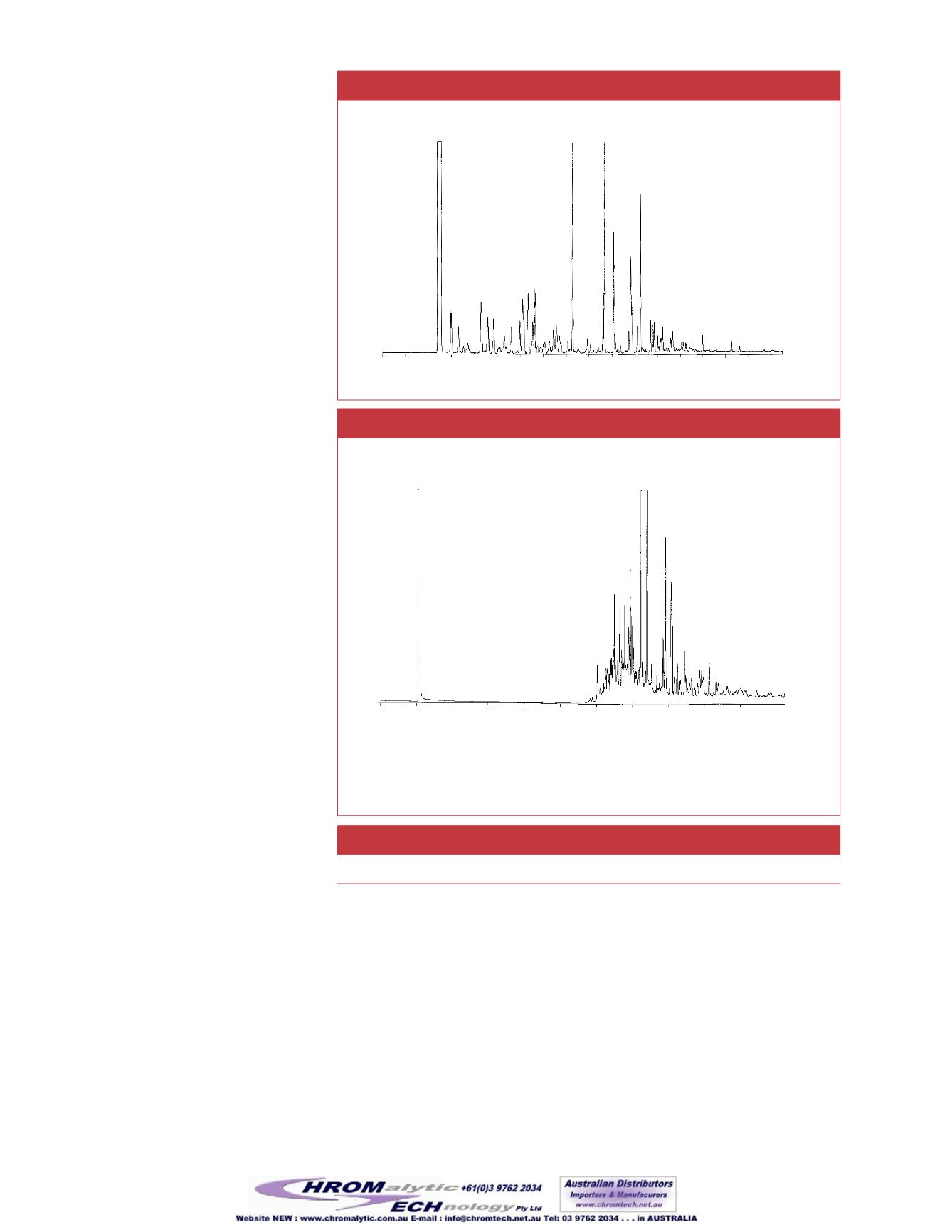
RestekCorporation
(800) 356-1688
After establishing the correct conditions
toobtain complete resolutionof the test
mix components, the analystmust then
calibrate the instrument. In firedebris
analysis, this involves purchase and
preparationof common accelerants used
to ignite fireswith subsequent injection
into theGC.Quantitationof unknown
samples is not performed. The analyst
must providepositive identification to
the field investigators of any accelerants
found in the samples collected. Todo
this, the analystmust be able to
recognize typical chromatographic
patterns of each accelerant.
Figure2
shows the chromatographicpattern
obtained from an injectionof an
unleadedgasoline standard.
To further complicate this analysis,
many factorswill change the chromato-
graphicpatternobtained from fire
debris. The first isweatheringof the
material from the heat of the fire along
withdilutionofwater used to extin-
guish the blaze. Thisweathering can
dramaticallychange thechromato-
graphicpatternof thematerial. Typi-
cally, lower boilingmaterials are lost by
theheat, leaving thehigher boiling
compounds remaining. This typeof
weathering canbe simulated in the
laboratoryby evaporating thematerial
under controlled conditions. The
advantageof performing theevapora-
tion in the laboratory is that the exact
amount ofweight loss compared to the
original startingmaterial canbe
measured and controlled.
Figure3
shows the analysis of a 99%weathered
unleadedgasoline. Thegasolinehas
beenweathered to a 99%weight loss
and an exact concentration calibration
standardwas preparedwith the
remainingmaterial.By analyzing
knownweatheredproducts, the analyst
canmore readily recognize the typeof
original startingmaterial.
There are five basic classes of complex
petroleumdistillatesnormally identifi-
able in arson samples.A sixth class of
accelerants (Class 0) includes single
compounds sometimesusedand
identified.
Table I
shows the complete
list of classes, typical chromatographic
rangeof eachmaterial (basedupon
hydrocarbon elution), and examples of
each type.
UnleadedGasolineStandard (Unweathered)
Figure 3
UnleadedGasoline (99%Weathered)
Table I - TypicalHydrocarbons
Class #
Range Examples
1 LightPetroleum
C4-C8 Pocket lighter fuel, petroleum ethers,
some rubber cement solvents
2 Gasoline
C4-C12 Gasoline (ALL), some camping fuels
3 MediumPetroleum
C8-C12 Mineral spirits, paint thinners, some
Distillates (MPD)
torch fuels, some charcoal fuels, some
charcoal starters
4 Kerosene
C9-C16 Kerosene, No. 1FuelOil, Jet-AFuel
Oil, Jet-AFuel, some charcoal starters,
some torch fuels
5 HeavyPetroleum
C10-C23 No. 2FuelOil, Diesel Fuel #2
Distillates (HPD)
0 Unclassified
Variable Alcohols, acetone, toluene, some lamp
oils, camping fuels, lacquer thinners
Conditions for Figures 2& 3:
30m, 0.53mm ID, 1.50µmRtx
®
-1 (cat.# 10170).
Oven temp.:
40°C (hold 3min.) to 75°C@ 15°C/min. to 275°C@ 20°C/min. (hold 5min.);
Inj./det. temp.:
250°C/285°C;
Carrier gas:
hydrogen;
Linear velocity:
50cm/sec. set @ 40°C;
FID sensitivity:
4.10 x 10
-9
AFS
Split ratio:
30:1
Figure 2
min. 2 4 6 8 10
14 16 18 20
12
22 24 26 28 30 32 34
4
8 12 16 20 24
32 36 40 44
28
min.


